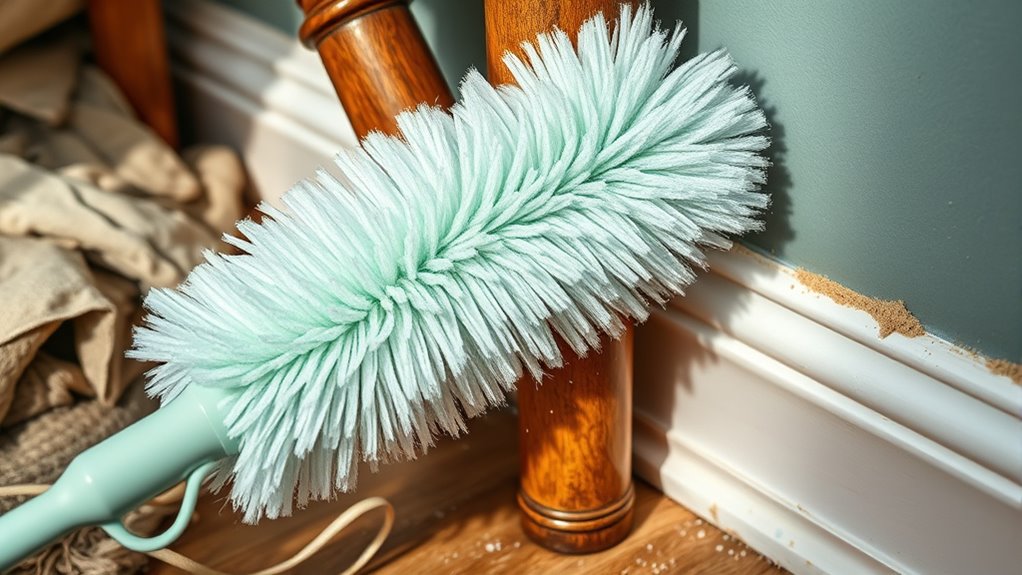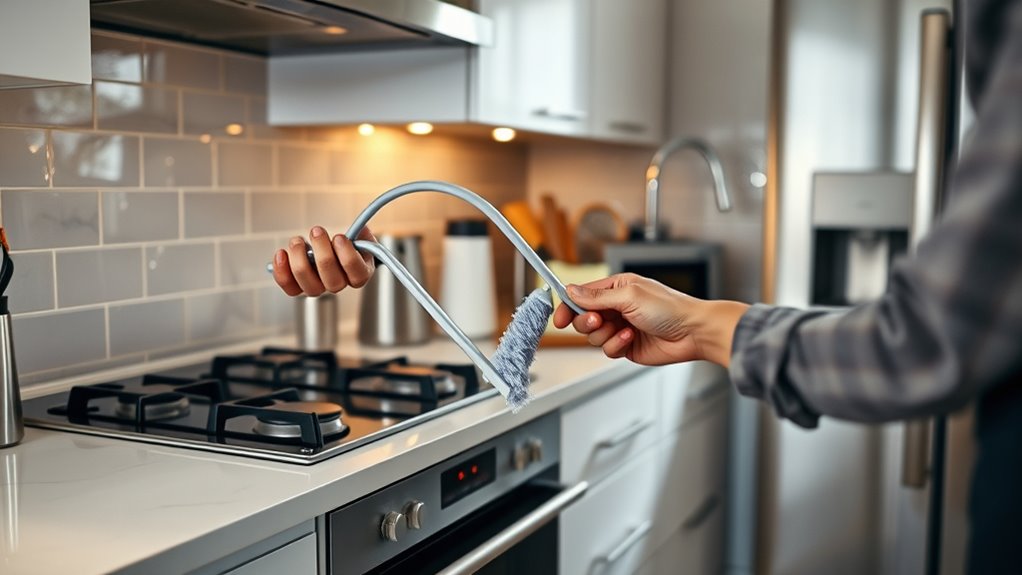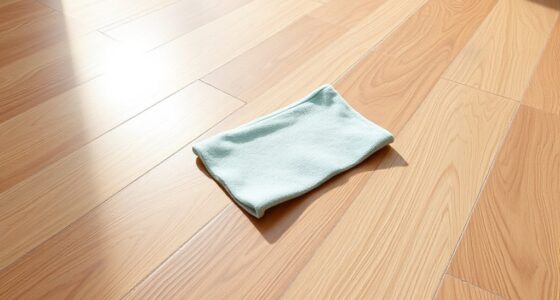To clean around obstacles and tight corners, use flexible tools like crevice attachments, small handheld vacuums, and angled brushes to reach difficult spots. Move slowly and methodically, angling tools to slide into narrow spaces without missing dirt. Dust first, then vacuum for thoroughness, and switch tools as needed for different surfaces. Maintain your tools for ideal performance, and if you follow these tips, you’ll discover more techniques to make cleaning easier and more efficient.
Key Takeaways
- Use crevice tools and flexible attachments to access narrow corners and tight spaces effectively.
- Move tools slowly and at an angle to slide into difficult spots without missing areas.
- Dust first with brushes or microfiber cloths, then vacuum for thorough cleaning around obstacles.
- Switch between vacuum attachments and brushes for different surfaces and hard-to-reach areas.
- Inspect and re-clean spots as needed, maintaining tools for optimal performance.

Cleaning around obstacles and tight corners can be challenging, but with the right techniques, you can achieve a thorough clean without hassle. The key is in tool selection and applying effective technique tips to reach those awkward spaces. Start by choosing the right tools; a variety of brushes, smaller vacuums, and flexible attachments will make your job much easier. For narrow corners, a crevice tool is ideal because it fits into tight spaces and allows you to direct suction precisely where you need it. For furniture legs, baseboards, or behind appliances, a small handheld vacuum or a brush with a flexible handle can reach into crevices without disturbing everything around it.
When tackling obstacles like furniture legs or appliances, move slowly and methodically. It’s tempting to rush through, but taking your time helps you avoid missing spots. Technique tips include angling your tool so it can slide into tight spots and using gentle, consistent pressure. For example, when vacuuming along baseboards, hold the crevice tool flat against the wall and work in smooth, overlapping strokes. If you’re using a brush attachment, keep it steady and make sure to go along the edges and corners, loosening dust before suctioning it away.
Another helpful tip is to utilize multiple tools for different surfaces and obstacles. For instance, a microfiber cloth on a flexible duster can reach behind radiators or under furniture that a vacuum alone might struggle with. When dusting, start at the top and work down, preventing debris from falling onto already cleaned areas. For stubborn dirt or grime in corners, a small, stiff-bristled brush can dislodge debris without scratching surfaces. Following proper GMC tuning techniques, ensuring your tools are in good condition and suited for the task, can further improve cleaning efficiency. Finally, always finish by inspecting your work to ensure no spots are missed and re-clean areas if necessary.
Frequently Asked Questions
What Tools Are Best for Cleaning Behind Large Furniture?
To clean behind large furniture effectively, you should use a vacuum attachment designed for tight spaces. A duster extension is also helpful to reach narrow gaps and crevices without moving heavy pieces. These tools let you remove dust and debris easily, saving time and effort. Make sure to switch attachments as needed, and gently maneuver around obstacles to avoid damage or injury while cleaning behind your furniture.
How Can I Prevent Scratching Walls When Cleaning Tight Corners?
To prevent scratching walls when cleaning tight corners, you should add wall padding or install corner guards to protect the surfaces. Use soft cloths or microfiber mops to gently clean near walls, avoiding harsh scrubbing that can cause damage. Keep a small, angled brush handy for hard-to-reach spots, ensuring you don’t accidentally scrape against the walls. These simple steps help keep your walls safe and clean.
Are There Eco-Friendly Methods for Cleaning Around Obstacles?
Think of eco-friendly cleaning as planting seeds for a healthier planet. You can do this by choosing biodegradable cleaners that break down naturally and avoid harming the environment. Pair them with reusable cleaning tools, like cloths and brushes, to cut waste. These methods not only protect the earth but also keep your space fresh and safe. Eco-cleaning is a small step that makes a big difference.
How Often Should I Clean Hard-To-Reach Areas?
You should clean hard-to-reach areas at least once a month to prevent dirt accumulation. Depending on how much dust and debris gather, you might need to clean more often, especially in high-traffic or dusty spaces. Regular cleaning helps keep these spots free of dirt buildup and maintains a cleaner, healthier environment. Set a cleaning schedule based on the level of dirt accumulation and your household’s needs to stay on top of it.
What’s the Safest Way to Clean Delicate or Antique Items Obstructing Access?
Think of it as walking on eggshells—you want gentle touches. To clean delicate or antique items obstructing access, use soft brushes or microfiber cloths to prevent damage. Wear gloves for delicate item protection and work slowly to prevent accidental harm. Follow antique cleaning tips like avoiding harsh chemicals, and use minimal moisture. Patience is key; taking your time ensures you preserve their beauty while keeping them spotless.
Conclusion
Cleaning around obstacles and tight corners might be tricky, but with patience, it becomes second nature. Think of it as steering a maze—each obstacle is just another turn to master. When you get close to those tricky spots, focus on precision instead of speed, like savoring the details of a painting. With every careful sweep, you’ll turn chaos into clarity, transforming cluttered corners into pristine spaces—proof that even the smallest effort can make a big difference.









